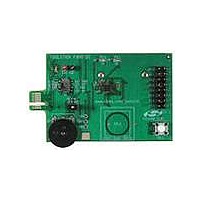TOOLSTICK990DC Silicon Laboratories Inc, TOOLSTICK990DC Datasheet - Page 12

TOOLSTICK990DC
Manufacturer Part Number
TOOLSTICK990DC
Description
DAUGHTER CARD TOOLSTCK C8051F990
Manufacturer
Silicon Laboratories Inc
Series
ToolStickr
Type
MCUr
Datasheet
1.TOOLSTICK990DC.pdf
(14 pages)
Specifications of TOOLSTICK990DC
Contents
Daughter Card
Processor To Be Evaluated
C8051F990
Processor Series
C8051F9xx
Interface Type
USB
Lead Free Status / RoHS Status
Lead free / RoHS Compliant
For Use With/related Products
C8051F990
Lead Free Status / Rohs Status
Lead free / RoHS Compliant
Other names
336-1964
To olSt ick-F 990D C
7. Additional Demo Examples
In addition to the F990DC_FeaturesDemo example firmware, the ToolStick download package also includes a
software example demo named F990DC_ADC0_ExternalInput.c. The instructions for running this example can
be found at the top of the source file. A capacitive sensing example is also installed with the Quicksense tools.
8. Using the C8051F990 Daughter Card as a Development Platform
The prototyping area on the ToolStick C8051F990 Daughter Card makes it easy to interface to external hardware.
All of the digital I/O pins are available so it possible to create a complete system.
8.1. C8051F990 Pin Connections
It is important to note that if external hardware is being added, some of the existing components on the board can
interfere with the signaling. The following is a list of port pins on the C8051F990 that are connected to other
components:
See the daughter card schematic in Section 10 for more information.
8.2. C2 Pin Sharing
On the C8051F912, the debug pins, C2CK, and C2D, are shared with the pins /RST and P2.7 respectively. The
daughter card includes the resistors necessary to enable pin sharing which allow the /RST and P2.7 pins to be
used normally while simultaneously debugging the device. See Application Note “AN124: Pin Sharing Techniques
for the C2 Interface” at
9. Information Locations
Example source code is installed by default in the “C:\SiLabs\MCU\ToolStick\F990DC\Firmware” directory during
the ToolStick installation.
Documentation for the ToolStick kit, including this User’s Guide, can be found by default in the
C:\SiLabs\MCU\ToolStick\Documentation and the C:\SiLabs\MCU\ToolStick\F990DC\Documentation directories.
The installer for the ToolStick software is available at www.silabs.com/toolstick.
12
P0.2—This pin is connected to the P0.2 switch. The switch and R10 can be safely removed from the daughter
card if they are not needed.
P0.3—This pin is connected to a capacitive touch sense switch. The 0 resistor R15 can be safely removed
from the daughter card if the capacitive touch sense switch is not needed.
P0.4, P0.5—These pins are connected directly to the ToolStick Base Adapter for UART communication.
P0.6—This pin is connected to the output of the potentiometer. The 0 resistor R11 can be removed to
disconnect the potentiometer from the pin.
P1.0, P1.1—These pins are connected directly to the ToolStick Base Adapter’s GPIO pins. By default, these
GPIO pins on the Base Adapter are high-impedance pins so they will not affect any signaling. Configuring these
pins on the Base Adapter to output pin or handshaking pins could affect signaling.
P1.3—This pin is connected to the power source detect signal.
P1.5—This pin is connected to the potentiometer enable signal. This allows the potentiometer to be disabled by
software when not in use. The 0 resistor R11 can be safely removed from the daughter card to disconnect the
potentiometer enable from the pin.
P0.0—This pin is connected to the cathode (-) of the red LED on the daughter card. The LED or R4 resistor can
be removed to disconnect the LED from the pin.
P0.1—This pin is connected to the cathode (-) of the yellow LED on the daughter card. The LED or R5 resistor
can be removed to disconnect the LED from the pin.
P1.6, P1.7—These pins are connected to a 32kHz crystal.
www.silabs.com
for more information regarding pin sharing.
Rev. 0.2



















